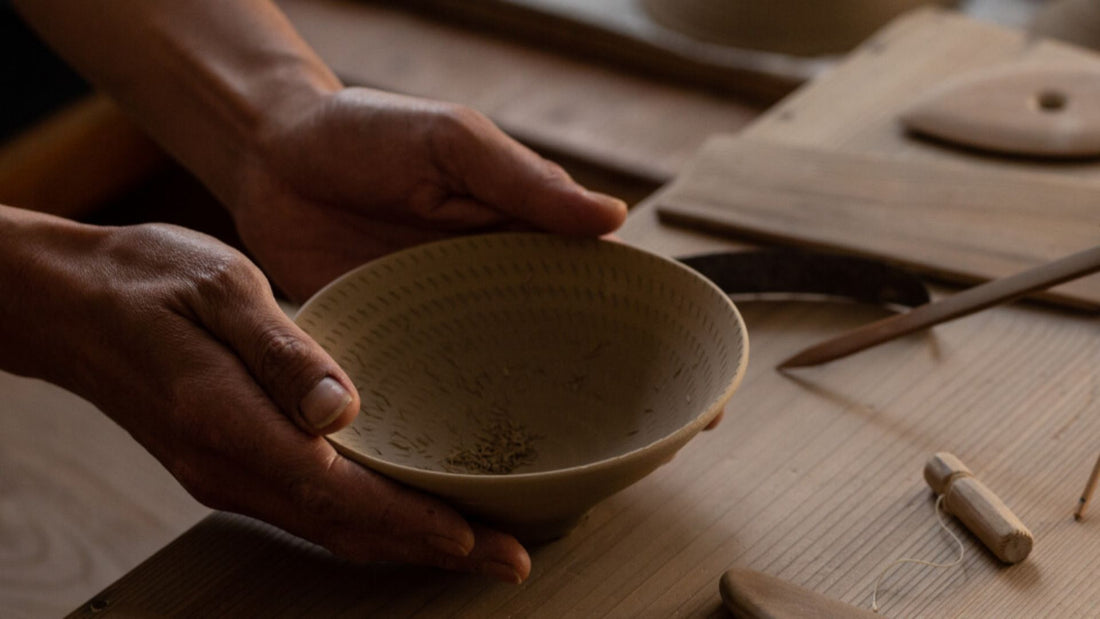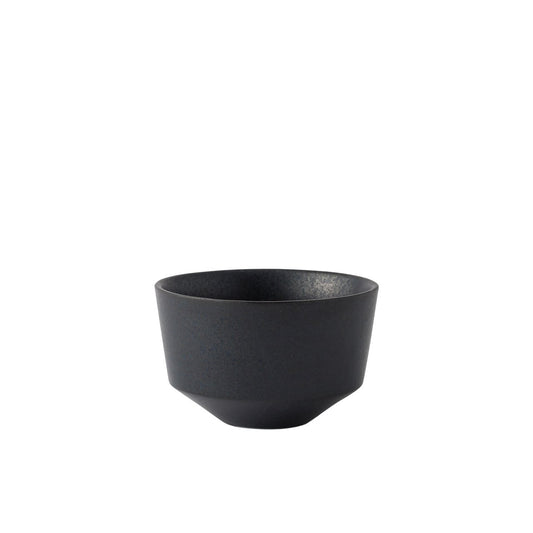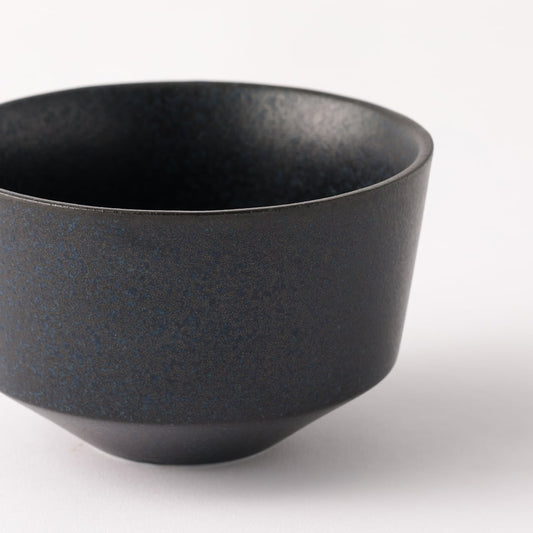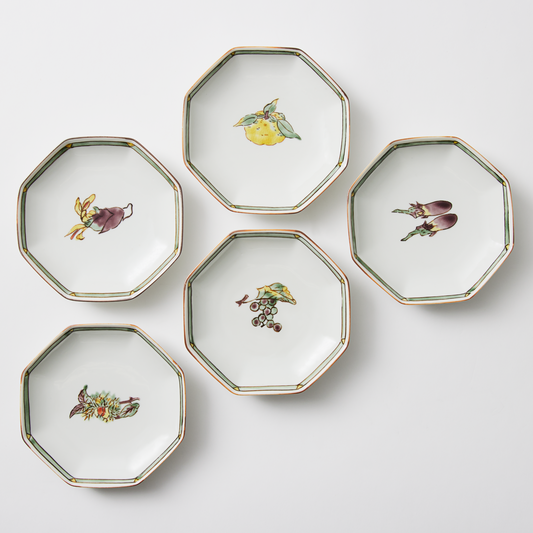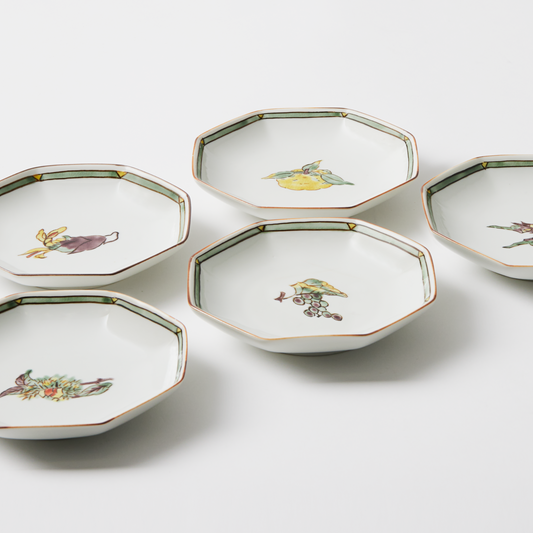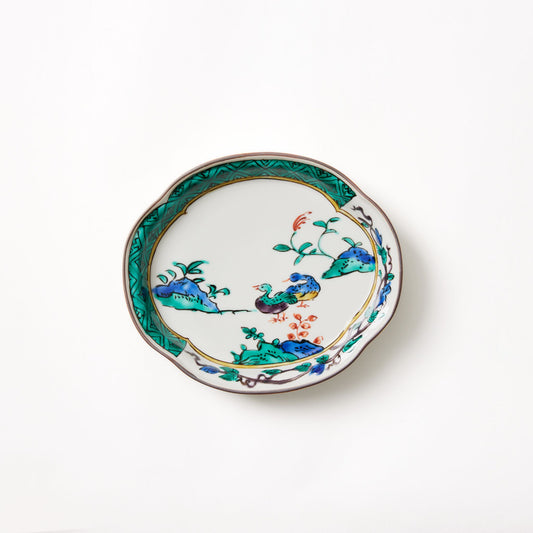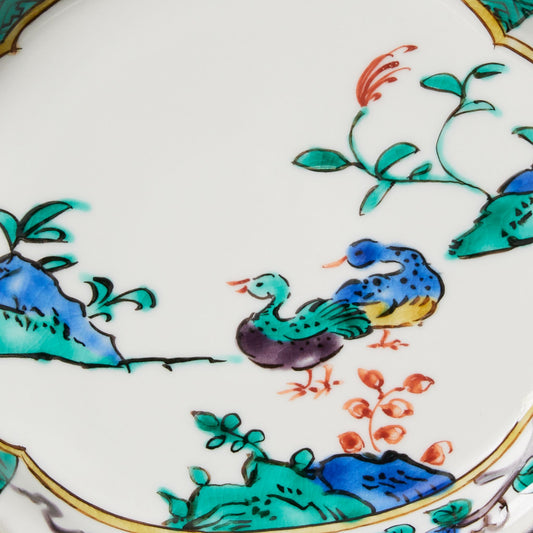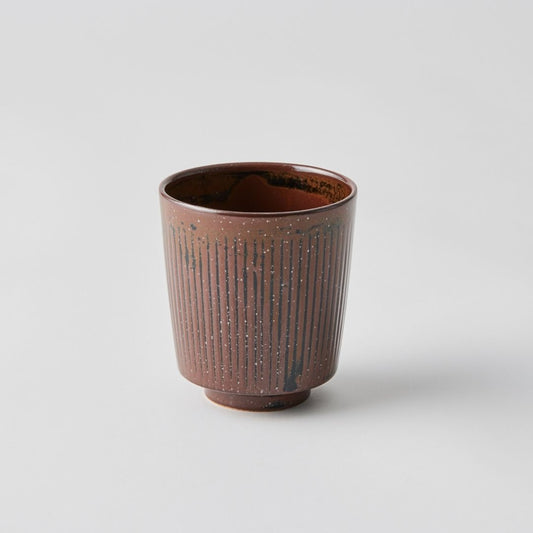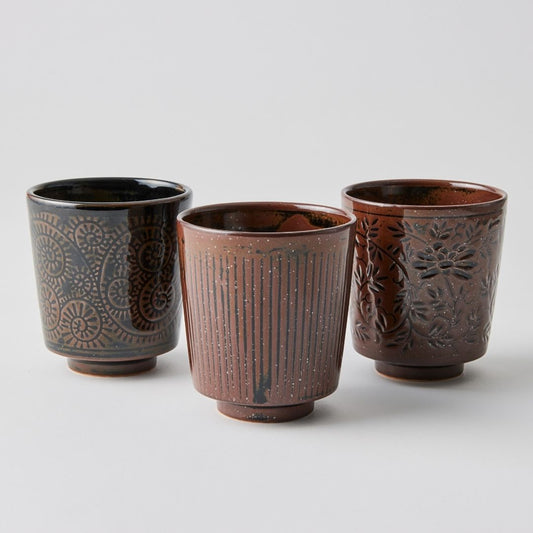Prepare to be enchanted by the symphony of artistry and tradition that has been carefully composed over centuries. This guide is your ticket to an immersive experience, where we invite you to embark on a visual and intellectual odyssey through the world of Japanese pottery. From the ancient kilns that birthed this craft to the contemporary studios that continue to shape its future, we will unravel the intricate details of diverse styles, techniques, and the cultural significance that breathes life into each and every masterpiece.
Join us as we journey to the very heart of this timeless art form, celebrating the remarkable artists, their captivating stories, and the exquisite vessels that have triumphed over the passage of time.
Contents
- A Brief History of Japanese Pottery and Porcelains
- Different Types of Japanese Porcelain and Pottery (Yakimono)
- Kutani Porcelain (Kutani Yaki / Kutani Ware)
- Mino Pottery (Mino Yaki / Mino Ware)
- Bizen (Bizen Yaki / Bizen Ware)
- Arita (Arita Yaki / Arita Ware)
- Kiyomizu Porcelain (Kyo Yaki / Kiyomizu Ware)
- Hasami Porcelain (Hasami Yaki / Hasami Ware)
- Shigaraki (Shigaraki Yaki / Shigaraki Ware)
- Seto Porcelain (Seto Yaki / Seto Ware)
- Imari Porcelain (Imari Yaki / Imari Ware)
- Hagi (Hagi Yaki / Hagi Ware)
- Tokoname (Tokoname Yaki / Tokoname Ware)
- Mashiko (Mashiko Yaki / Mashiko Ware)
- Yachimun
- Tamba (Tamba Yaki / Tamba Ware)
- Tsuboya (Tsuboya Yaki / Tsuboya Ware)
- Oborisoma (Oborisoma Yaki / Oborisoma Ware)
- Popular Traditional Japanese Designs and Motifs
- General Care Tips for Traditional Japanese Pottery and Porcelain
- In Conclusion
A Brief History of Japanese Pottery and Porcelain

The rich history of Japanese pottery is an artistic tapestry woven through centuries, reflecting the nation's deep cultural roots and evolving artistic sensibilities. Dating back to the Jomon period (around 10,000 BCE), Japan's first inhabitants crafted rudimentary coil and pinch pots adorned with distinctive rope-like patterns. Fast forward to the Yayoi period (300 BCE to 300 CE), and the introduction of wheel-throwing techniques transformed pottery into a more refined art form, setting the stage for centuries of innovation.

During the Kofun and Asuka periods (300-710 CE), Korean potters brought transformative knowledge, introducing new glazing methods and kiln designs. The Nara period (710-794 CE) witnessed the emergence of the first official kilns, laying the foundation for the subsequent flourishing of pottery in the Heian period (794-1185 CE). It was during this era that Seto and Tokoname kilns gained prominence, producing wares for tea ceremonies and daily use.

The Kamakura period (1185-1333 CE) marked a turning point with the ascendance of the Zen Buddhist aesthetic, influencing the development of tea ceremony utensils and the renowned Raku ware. The Muromachi period (1336-1573 CE) ushered in an era of heightened artistic expression, with the advent of iconic tea masters like Sen no Rikyu, further shaping the trajectory of Japanese ceramics.

The Momoyama period (1573-1603 CE) witnessed the rise of the influential tea master Hideyoshi, leading to a burst of creativity and experimentation in pottery. The Edo period (1603-1868 CE) brought about the democratization of pottery, with the proliferation of kilns across Japan and the establishment of distinct regional styles. The Meiji era (1868-1912 CE) saw Japan opening up to the world, influencing pottery with Western aesthetics.
In the contemporary era, Japanese potters seamlessly blend tradition and innovation, creating an ever-evolving landscape of ceramics that continues to captivate enthusiasts worldwide.
Different Types of Japanese Porcelain and Pottery (Yakimono)
Let's now embark on an exciting journey to explore the captivating world of Japanese tableware. Get ready to uncover a wide range of pottery and porcelain styles from different regions of Japan.
Kutani Porcelain (Kutani Yaki / Kutani Ware)

Kutani ware or ”Kutani-yaki” (九谷焼) is a stunning style of Japanese porcelain hailing from the southern region of Ishikawa prefecture. What sets it apart is its vibrant hues and intricate patterns that exude elegance.
The origins of Kutani ware can be traced back to the 17th century, when Goto Saijiro, a skilled potter who honed his craft in Arita, returned to his hometown and established his own kiln. Although production sadly ceased after just half a century, Kutani ware made a triumphant comeback around a hundred years later and has remained a beloved and sought-after style of Japanese ceramics ever since.The evolution of Kutani ware can be observed through its distinct styles during different periods.

The first 50 years, known as "Ko-Kutani" (古九谷), showcased the classical five-color style called "Gosai-de" (五彩手), which gained immense popularity. However, after its re-opening, Kutani ware took on a new identity as "Saiko-Kutani" (再興九谷), with various styles emerging. Some styles remained conservative in their coloring, while others embraced the striking combination of red and gold.
If you're planning a trip to Ishikawa prefecture, don't miss the opportunity to explore the fascinating world of Kutani ware at the Kutaniyaki Art Museum.
Mino Pottery (Mino Yaki / Mino Ware)

Mino ware or “Mino-yaki” (美濃焼) has a rich history that dates back over 1,300 years. It originated in the Mino region of Gifu Prefecture and flourished during the Momoyama period. This was a time when tea ceremonies gained popularity, and Mino ware evolved significantly to meet the demands of this cultural practice.
One of the remarkable aspects of Mino ware is its wide range of styles. Setoguro, Shino, Oribe, and Yellow Seto are among the most iconic styles. Each style has its own unique characteristics, showcasing diverse patterns, textures, and glazing techniques. For instance, Shino is famous for its thick, white glaze with tiny pinholes, while Oribe features vibrant green copper glazes and bold patterns.

What sets Mino ware apart is its versatility and the sheer variety of styles it encompasses. The Mino region's close proximity to Seto, another renowned pottery site, fostered a vibrant exchange of techniques and styles. This cross-pollination further enriched Mino's ceramic legacy, making it a truly exceptional and influential pottery tradition.
To uncover additional information about Mino ware, make your way to the Mino ware website.
Bizen (Bizen Yaki / Bizen Ware)

Bizen ware or “Bizen-yaki” (備前焼) has its roots in Bizen province, which is now part of Okayama Prefecture. With a history spanning over a millennium, it holds a significant place among Japan's ancient kilns.

During the Momoyama period (1573-1603), it gained immense popularity and found its way into the elegant abodes of samurais and traditional tea ceremonies. What sets Bizen ware apart is its distinct lack of glaze, giving it a raw and organic appearance. Its unique characteristics are a result of the wood-fired kiln process, which leaves behind beautiful ash glazes and kiln markings. Unlike many other Japanese ceramics that are adorned with paintings or additional glazes, Bizen ware embraces the natural beauty of the clay and the unpredictable outcomes brought forth by kiln variations.
Did you know that Bizen pottery gets its unique appearance from a firing process that can take up to 10-14 days? It's fascinating how the specific clay from the region contributes to its distinct look. This traditional pottery holds immense value not only for its historical importance but also for its natural beauty.
If you want to learn more about Bizen ware, make sure to check out the Okayama tourism website.
Arita (Arita Yaki / Arita Ware)

Of the many Japanese pottery styles, Arita ware, or “Arita-yaki”(有田焼) holds the distinction of being the pioneer in Japanese porcelain craftsmanship among the various pottery styles. Originating from Saga prefecture in the western part of Japan, this exquisite porcelainware gained fame as Imari-yaki due to its exportation from the Imari port to Europe.
Despite its delicate facade, the Arita ware boasts remarkable strength attributed to the meticulous selection of materials used in crafting these masterpieces. The alluring white finish adorned with vibrant motifs, particularly the enchanting indigo blue and red patterns, adds an irresistible charm to these exquisite pieces.

In 1616, during the Edo period, the discovery of porcelain clay near the Arita region marked the birth of Arita ware. Initially, the designs were modest, but in 1647, a burst of creativity led to the incorporation of vibrant and intricate drawings, shaping the exquisite designs we admire today.
Kiyomizu Porcelain (Kyo Yaki / Kiyomizu Ware)

Kyo ware or “Kyo-yaki” (京焼) encompasses a wide range of pottery styles that have flourished in the Kyoto area. With no specific style to confine it, Kyo ware showcases a diverse array of pottery and porcelainware designs. Its rich history dates back to the late 16th century, and since then, it has continuously evolved and embraced the ever changing cultural landscape of Kyoto.

Kyoto, being a cultural hub for centuries, has witnessed the evolution of various artistic practices. Kyo ware, in particular, has flourished alongside esteemed disciplines like the Japanese tea ceremony, flower arranging, and the appreciation of Japanese incense, known as “Sado”(Japanese tea ceremony), “Kado” (Japanese flower arranging), and “Kodo” (appreciation of Japanese incense) respectively. Over time, these art forms have intertwined, creating a rich tapestry of cultural heritage in Kyoto.
You'll come across numerous Kyo ware pieces when you explore the enchanting Kiyomizudera Temple. However, if you're looking for more, make sure to pay a visit to the Kyoto Museum of Crafts and Design as well.
Hasami Porcelain (Hasami Yaki / Hasami Ware)

Hasami Ware or “Hasami-yaki” (波佐見焼), hails from the picturesque town of Hasami in Nagasaki Prefecture, Japan, and is renowned for its timeless elegance and functional simplicity. With a history dating back to the early 17th century, Hasami Ware has evolved into a celebrated ceramic tradition deeply rooted in the region's rich pottery heritage. Nestled amid the scenic landscape of western Kyushu, Hasami has been a hub of ceramic production, with its wares gaining prominence for both their aesthetic appeal and utilitarian design.

Characterized by clean lines, earthy hues, and a minimalist aesthetic, Hasami Ware embodies the essence of Japanese craftsmanship. The clay used in Hasami Ware is carefully sourced from local mines, ensuring a distinctive texture and durability. One of its defining features is the matte glaze that imparts a subtle sophistication to each piece. The crafting of Hasami Ware often involves a meticulous balance between tradition and innovation, with contemporary artisans continuing to honor centuries-old techniques while infusing a modern sensibility.
What sets Hasami Ware apart is its versatile functionality. Many pieces are designed with modular dimensions, allowing for seamless stacking and mixing of different items. This intentional modularity not only enhances the visual appeal but also caters to the practical needs of users.
Shigaraki (Shigaraki Yaki / Shigaraki Ware)

Shigaraki ware or “Shigaraki-yaki” (信楽焼) is a remarkable form of stoneware pottery crafted in Koka, Shiga prefecture, situated to the east of Lake Biwa. This exquisite pottery is renowned for its delightful Tanuki figures that can be discovered throughout the entire country. In addition to the esteemed kiln in Seto, the Shigaraki kiln holds a significant place as one of the Six Ancient Kilns.

The Shigaraki ware is crafted using a material that is known for its rough texture, substantial weight, and exceptional heat resistance. These unique qualities make it the perfect choice for creating large-scale items like tiles, charcoal braziers, clay pots, and, of course, the iconic Tanuki figures.
During the late 16th century, the emergence of Japanese tea ceremonies led to the creation of Japanese tea bowls. These bowls, with their textured surfaces and comforting warmth, played a significant role in fostering the "Wabi-Sabi" culture.
Seto Porcelain (Seto Yaki / Seto Ware)

Seto ware or “Seto-yaki” (瀬戸焼) is undeniably one of the most beloved styles of Japanese ceramics. Its popularity is so immense that the term "Seto-mono" has become synonymous with Japanese pottery as a whole. This exquisite pottery is crafted in the charming city of Seto, located in Aichi prefecture.
Seto has a rich history in ceramics that stretches back to the 5th century. It proudly holds the distinction of being one of Japan's "Six Ancient Kilns" (日本六古窯). Interestingly, it wasn't until the late 10th century that Seto ware truly gained popularity, as kilns began to multiply across the region.

In this region, Seto ware serves as an umbrella term for a myriad of pottery styles. From earthy, single-hued motifs to vibrant and meticulously symmetrical designs, the variations are endless. Yet, what truly sets Seto ware apart is the exceptional craftsmanship and employment of top-notch materials that elevate these creations to unparalleled heights.
Imari Porcelain (Imari Yaki / Imari Ware)

Imari ware, also known as "Imari-yaki" (伊万里焼), encompasses a wide variety of porcelain produced in the Arita region of Saga Prefecture.
While Arita ware takes the spotlight within the Imari umbrella, other styles fall under its realm, such as Mikawachi ware (三川内焼), Hasami ware (波佐見焼), and Nabeshima ware (鍋島焼). Mikawachi ware stands out with its mesmerizing deep blue underglaze designs, adding a touch of sophistication to each piece. Hasami ware, originating from Nagasaki, embraces simplicity and functionality, showcasing a minimalist aesthetic. On the other hand, Nabeshima ware, created exclusively for the Japanese elite, boasts refined techniques and intricate designs, often inspired by the beauty of nature. Imari ware truly offers a diverse range of styles, each with its allure and character.

Imari wares are renowned for their vibrant colors, intricate designs, and impeccable glaze. When compared to other Japanese ceramics, Imari ware takes center stage with its ornate beauty, adorned with intricately painted patterns, while other wares may lean towards a more natural or subdued aesthetic.
For a deeper understanding of the captivating Imari ware, pay a visit to the official website of Imari city.
Hagi (Hagi Yaki / Hagi Ware)

Hagi Ware or “Hagi-yaki” (萩焼), originating from the town of Hagi in Yamaguchi Prefecture, embodies a serene aesthetic rooted in Zen philosophy.
With a history dating back to the early 17th century, Hagi Ware has become synonymous with the quiet beauty of imperfection. Crafted primarily for the tea ceremony, Hagi Ware pieces showcase the distinctive local clay, rich in iron, which contributes to the unique textures and warm earthy tones. The kilns of Hagi are known for their wood-fired ceramics, resulting in vessels that exude a rustic charm and gentle elegance.

Hagi Ware is celebrated for its captivating glazes, ranging from milky whites to subtle pinks and deep reds. Its hallmark lies in the "hi-iro" or the beauty of cracks that emerge over time, enhancing the vessel's character. This pottery style prioritizes simplicity, irregular shapes, and a tranquil aesthetic, emphasizing the connection between the user and tableware. Each piece reflects the spirit of wabi-sabi, embracing the transient nature of existence and the beauty found with time.
Tokoname (Tokoname Yaki / Tokoname Ware)

Tokoname Ware or “Tokoname-Yaki” (常滑焼), hailing from the historic pottery town of Tokoname in Aichi Prefecture, boasts a legacy dating back over a millennium.
Renowned for its exceptional craftsmanship, Tokoname has been a center for ceramic production since the Heian period (794–1185). The clay used in Tokoname Ware is sourced locally, lending the pieces a distinct reddish-brown hue. It is this unique clay, combined with meticulous artistry, that has made Tokoname Ware a staple in Japanese pottery.

Tokoname Ware is characterized by its bold, functional forms and a deep, lustrous finish achieved through high-temperature firing. Teapots and tea-related vessels dominate Tokoname's production, with their functional design catering to the needs of tea enthusiasts. The clay's porous nature is believed to enhance the flavor of tea, making Tokoname Ware a preferred choice for tea connoisseurs.
The town's rich history and commitment to traditional methods have earned Tokoname a prestigious place in the world of Japanese ceramics.
Mashiko (Mashiko Yaki / Mashiko Ware)

Mashiko Ware also known as "Mashiko-yaki" (益子焼), originating from the town of Mashiko in Tochigi Prefecture, embodies the spirit of Mingei, the Japanese folk art movement.
It gained prominence in the 20th century under the influence of potter Shoji Hamada. Mashiko Ware reflects a commitment to utilitarian simplicity, emphasizing the natural beauty of unadorned clay. The town's location, surrounded by rich clay deposits, has been instrumental in shaping the distinctive characteristics of Mashiko Ware.

Known for its earthy aesthetics, Mashiko Ware often features robust forms with textured surfaces. The pieces, fired in wood-burning kilns, showcase warm tones and natural variations. The crafting process involves a blend of tradition and innovation, with potters embracing the Mingei philosophy of creating everyday objects that are both functional and aesthetically pleasing.
Mashiko Ware has gained global recognition for its unpretentious beauty, showcasing the seamless integration of form and function.
Yachimun

Yachimun, the pottery tradition of Okinawa, holds a distinct place in Japan's cultural mosaic. With a heritage deeply intertwined with the Ryukyu Kingdom, Yachimun reflects the vibrant cultural influences of Okinawa's unique history. The term "Yachimun" itself means pottery in the Okinawan language.

Yachimun pottery embodies the spirit of Okinawa, featuring diverse forms from practical tableware to ornate decorative pieces. The distinctive red clay used in Yachimun pieces, coupled with vivid glazes, creates a striking visual impact. Traditional motifs often draw inspiration from Okinawa's natural surroundings and cultural symbols. Yachimun continues to evolve, blending traditional techniques with contemporary interpretations, and stands as a testament to Okinawa's rich artistic heritage.
Tamba (Tamba Yaki / Tamba Ware)

Tamba Ware also known as Tamba-Tachikui ware (丹波立杭焼), hailing from the Tamba region in Hyogo Prefecture, Japan, boasts a rich history dating back over 800 years.
Renowned for its robust and unpretentious aesthetic, Tamba Ware reflects the distinct characteristics of the local clay and the natural surroundings. The crafting process often embraces the use of anagama kilns, and traditional wood-fired kilns, contributing to the unique finishes and earthy tones that define Tamba Ware. The pieces are known for their simplicity, showcasing the beauty found in imperfections and irregularities.

Tamba Ware is celebrated for its warm, earthy hues, ranging from deep browns to rustic yellows. The functional yet artful forms often feature textured surfaces, embodying a harmonious connection with nature. This pottery style includes a variety of vessels, from practical tableware to decorative items.
The crafters' dedication to preserving traditional techniques ensures that Tamba Ware remains an emblem of Japanese pottery heritage.
Tsuboya (Tsuboya Yaki / Tsuboya Ware)

Tsuboya ware or “Tsuboya-yaki” (壺屋焼) originates from the charming Tsuboya district in Naha, Okinawa.
This exquisite pottery is renowned for its rustic charm, boasting captivating shades of deep red and brown, which are achieved through the use of iron-rich clay and traditional firing techniques. The simplicity and functionality of Tsuboya ware reflect the distinctive island culture of Okinawa. Unlike other Japanese ceramics, Tsuboya pottery possesses a robust and earthy quality that beautifully embodies the everyday life of the Okinawan people.

With its roots tracing back to the 17th century, this art form beautifully merges traditional Okinawan pottery with influences from various Asian regions. An intriguing fact is that Tsuboya Street in Naha continues to thrive as a lively hub for pottery enthusiasts. Countless kilns and shops on this street carry forward the centuries-old tradition, making it a living testament to the abundant ceramic heritage of Okinawa.
Explore the fascinating world of Tsuboya ware by paying a visit to this website.
Oborisoma (Oborisoma Yaki / Oborisoma Ware)

Oborisoma ware or “Oborisoma-yaki” (大堀相馬焼) is a remarkable ceramic tradition that has been treasured for centuries in the northeastern region of Japan. This ancient pottery style dates back to the late Heian period and holds the prestigious title of being the oldest in the Tohoku region, specifically originating from the Namie area in Fukushima Prefecture.

Oborisoma ware is renowned for its unique features. The pottery is exceptionally thin, giving it an almost see-through quality, and comes in delicate shades of pale blue or white. The intricate hand-painted designs add a touch of elegance and fragility to these exquisite pieces. What sets Oborisoma apart from other Japanese wares is its ethereal nature and the graceful beauty of its shapes. Surprisingly, despite its delicate appearance, it is highly praised for its remarkable strength and durability.
In the early 18th century, the production of Oborisoma ware came to a halt. However, a heartening revival took place in the 1970s, ensuring that this extraordinary craft still captivates pottery enthusiasts today.
To learn more about Oborisoma ware, visit the Oborisoma ware website.
Popular Traditional Japanese Designs and Motifs
Traditional Japanese tableware is adorned with a myriad of designs and motifs, each carrying profound cultural symbolism.

Cherry blossoms (sakura), plum blossoms (ume), pine trees, and bamboo are recurring motifs symbolizing the changing seasons and resilience. The iconic crane, often seen in tableware, represents longevity and good fortune. Additionally, koi fish, turtles, and floral patterns hold cultural significance, imparting a sense of harmony and balance to the dining experience.

Nature-inspired designs, such as waves, clouds, and stylized landscapes, are prevalent in Japanese tableware, reflecting a deep connection to the natural world. Traditional Japanese ceramics often incorporate minimalist aesthetics, allowing the beauty of the natural motifs to shine. The use of delicate brushstrokes and intricate detailing showcases the craftsmanship and artistry embedded in each piece.
General Care Tips for Traditional Japanese Pottery and Porcelain

Ensuring that you care for your traditional Japanese tableware to ensure longevity is important for many who adore these crafts. Here are our recommended tips for caring for your Japanese pottery and porcelain.
- Handwashing: Wash pottery and porcelain items by hand using mild soap and warm water.
- Avoid Abrasives: Refrain from using abrasive scrubbers or harsh detergents that may damage delicate glazes.
- Avoid Sudden Temperature Changes: Gradual temperature changes are essential to prevent thermal shock, especially for items with delicate glazes.
- Storage: Store pottery and porcelain in a cool, dry place away from direct sunlight to preserve colors and prevent damage.
- Handle with Care: Be gentle when handling, and avoid stacking items to prevent scratching or chipping.
Please be aware that you should seek professional assistance if restoration is needed to ensure proper preservation and handling of valuable pieces. Alternatively, you can embrace the Japanese tradition of Kintsugi and repair your prized tableware and breath new life into them.
In Conclusion
At the end of our exploration of Japanese pottery and porcelain, we find ourselves immersed in a world where tradition and innovation coalesce. Each piece tells a story of craftsmanship, culture, and the enduring beauty of imperfection. As we navigate the delicate care required for these treasures, we are reminded that every crack, every brushstroke, is a testament to the artistry that has shaped Japanese ceramics throughout the centuries.
May our appreciation for this timeless art form continue to deepen, bridging the past with the present and fostering a legacy for generations to come.


